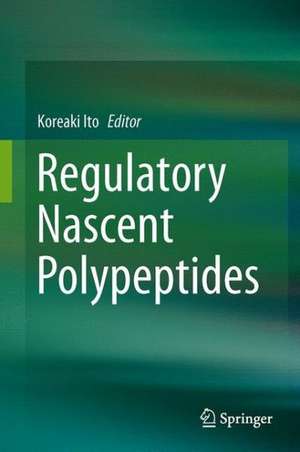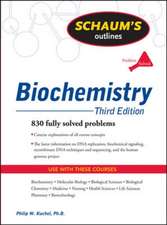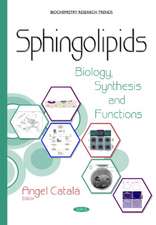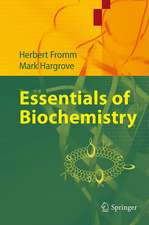Regulatory Nascent Polypeptides
Editat de Koreaki Itoen Limba Engleză Hardback – 31 aug 2014
| Toate formatele și edițiile | Preț | Express |
|---|---|---|
| Paperback (1) | 787.14 lei 38-44 zile | |
| Springer – 22 aug 2016 | 787.14 lei 38-44 zile | |
| Hardback (1) | 952.09 lei 6-8 săpt. | |
| Springer – 31 aug 2014 | 952.09 lei 6-8 săpt. |
Preț: 952.09 lei
Preț vechi: 1161.08 lei
-18% Nou
Puncte Express: 1428
Preț estimativ în valută:
182.21€ • 189.52$ • 150.42£
182.21€ • 189.52$ • 150.42£
Carte tipărită la comandă
Livrare economică 15-29 aprilie
Preluare comenzi: 021 569.72.76
Specificații
ISBN-13: 9784431550518
ISBN-10: 4431550518
Pagini: 328
Ilustrații: IX, 315 p. 75 illus., 62 illus. in color.
Dimensiuni: 155 x 235 x 27 mm
Greutate: 0.64 kg
Ediția:2014
Editura: Springer
Colecția Springer
Locul publicării:Tokyo, Japan
ISBN-10: 4431550518
Pagini: 328
Ilustrații: IX, 315 p. 75 illus., 62 illus. in color.
Dimensiuni: 155 x 235 x 27 mm
Greutate: 0.64 kg
Ediția:2014
Editura: Springer
Colecția Springer
Locul publicării:Tokyo, Japan
Public țintă
ResearchDescriere
This book highlights a new paradigm of translation control by regulatory nascent polypeptides, which is integrated into cellular regulatory systems. Translation lies in the hub of the central dogma of biology, in which the genetic information in the forms of 4-letter sentences is translated into 20-letter sentences: sequences of amino acids that constitute proteins, the functional molecules of life. The process involves a huge number of chemical reactions as well as physical movements of the ribosome along a messenger RNA and takes, on average, tens of seconds in prokaryotes and a few minutes in eukaryotes. Detailed knowledge about the progression of translation, called "elongation", only recently started to accumulate. Newly synthesized and growing polypeptides, called nascent polypeptides, can interact with the intra-ribosomal conduit, called the ribosomal exit tunnel, when they have some specific amino acid sequences, called "an arrest sequence". Such interaction leads to a halt in the elongation reaction. Resulting stalling of the ribosome on messenger RNA can affect the secondary structure and/or localization of the message in the cell, consequently leading to biological outputs such as elevation or reduction of a gene product. This book provides a first collection of knowledge focused on regulatory nascent polypeptides, which have been studied recently using diverse organisms including bacteria, plants, and animals. Readers will be impressed by a new paradigm showing that proteins can function even during the course of their biosynthesis and that the ribosome, the "factory" of protein production, interacts with and inspects its products to adjust the speed of completion of each product. Moreover, regulatory nascent polypeptides can sense or monitor physiological states of the cell and modulate its ability to arrest translation. Living organisms use such intricate control mechanisms of translational speed to regulate gene expression. This book will be a useful addition for established scientists while inspiring students and young scientists to gain deeper insights into the processes of expression of genetic information.
Cuprins
(1) Introduction 1. Biological significance of divergent sequences that stall the ribosome Koreaki Ito (Professor, Kyoto Sangyo University, Japan) and Shinobu Chiba (Assistant Professor, Kyoto Sangyo University, Japan) (2) The ribosomal tunnel 2. Structural basis for the exit tunnel-nascent chain interactions Roland Beckmann (Professor, Gene Center and Department of Biochemistry, Ludwig-Maximilians-Universität München, Germany) 3. Biochemical and biophysical properties of the ribosomal exit tunnel Carol Deutsch (Professor, Department of Physiology, University of Pennsylvania School of Medicine, USA) (3) Regulatory nascent chains sensing metabolites and drugs 4. Ribosomal stalling by TnaC, a tryptophan-sensing nascent chain Luis Rogelio Cruz-Vera (Assistant Professor, Department of Biological Sciences, University of Alabama in Huntsvill, USA. 5. Ribosomal stalling by antibiotic-sensing leader peptides that regulate antibiotic-resistance genes Alexander Mankin (Professor, Center for Pharmaceutical Biotechnology, University of Illinois at Chicago, USA.) 6. Ribosome stalling by the fungal arginine attenuator peptide Matthew S. Sachs (Professor, Texas A & M University) 7. Ribosome stalling by S-adenosyl methionine-sensing nascent peptide in plants Satoshi Naito (Professor, Hokkaido University. Japan) (4) Elongation-arresting nascent chains and translocation sensing 8. Amino acid motifs that induce elongation pausing Allen Buskirk (Department of Chemistry and Biochemistry, Brigham Young University, USA) 9. SecM as an elongation arresting nascent chain that senses and regulates protein export activity Koreaki Ito (Professor, Kyoto Sangyo University, Japan) 10. Translocation sensing by SecM Harris Bernstein (Senior Investigator, NIDDK, National Institutes of Health. USA) 11. MifM as an elongation arresting nascent chain that senses and regulates cellular activity of protein insertion into the membrane Shinobu Chiba (Assistant Professor, Kyoto Sangyo University, Japan) 12. Arrest-releasing forces generated by partition into the lipid phase of the membrane Gunnar von Heijne (Professor, Center for Biomembrane Research, Stockholm University, Sweden) 13. Nascent chain mediated localization of mRNA on the endoplasmic reticulum as an important step of unfolded protein response Kenji Kohno (Professor, Nara Institute of Science and Technology, Japan) 14. Co-translational recruitment of a targeting factor to the ribosome Ramanujan Hegde (Group Leader, MRC Laboratory of Molecular Biology, UK) 15. Signaling from within the ribosome Arthur E. Johnson (Professor, Texas A&M University, USA)
Notă biografică
Koreaki Ito, Senior Research Fellow, Kyoto Sangyo University
Textul de pe ultima copertă
This book highlights a new paradigm of translation control by regulatory nascent polypeptides, which is integrated into cellular regulatory systems. Translation lies in the hub of the central dogma of biology, in which the genetic information in the forms of 4-letter sentences is translated into 20-letter sentences: sequences of amino acids that constitute proteins, the functional molecules of life. The process involves a huge number of chemical reactions as well as physical movements of the ribosome along a messenger RNA and takes, on average, tens of seconds in prokaryotes and a few minutes in eukaryotes. Detailed knowledge about the progression of translation, called "elongation", only recently started to accumulate. Newly synthesized and growing polypeptides, called nascent polypeptides, can interact with the intra-ribosomal conduit, called the ribosomal exit tunnel, when they have some specific amino acid sequences, called "an arrest sequence". Such interaction leads to a halt in the elongation reaction. Resulting stalling of the ribosome on messenger RNA can affect the secondary structure and/or localization of the message in the cell, consequently leading to biological outputs such as elevation or reduction of a gene product. This book provides a first collection of knowledge focused on regulatory nascent polypeptides, which have been studied recently using diverse organisms including bacteria, plants, and animals. Readers will be impressed by a new paradigm showing that proteins can function even during the course of their biosynthesis and that the ribosome, the "factory" of protein production, interacts with and inspects its products to adjust the speed of completion of each product. Moreover, regulatory nascent polypeptides can sense or monitor physiological states of the cell and modulate its ability to arrest translation. Living organisms use such intricate control mechanisms of translational speed to regulate gene expression. This book will be a useful addition for established scientists while inspiring students and young scientists to gain deeper insights into the processes of expression of genetic information.
Caracteristici
Highlights an emerging paradigm: proteins can function during their biosynthesis
Is the first book to focus on hitherto unpredicted functions of nascent chains
Explains how dynamic translation processes uncover secrets of gene regulation
Includes supplementary material: sn.pub/extras
Is the first book to focus on hitherto unpredicted functions of nascent chains
Explains how dynamic translation processes uncover secrets of gene regulation
Includes supplementary material: sn.pub/extras












